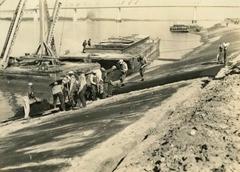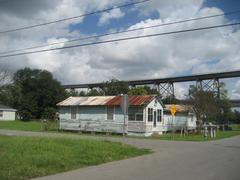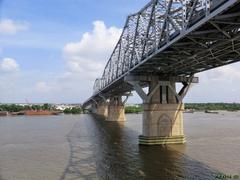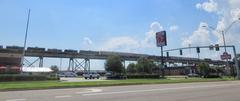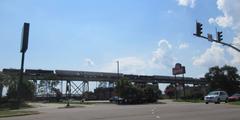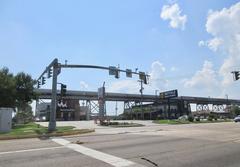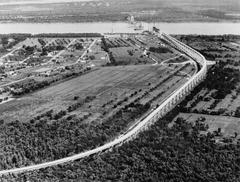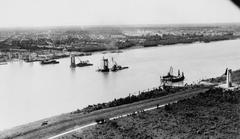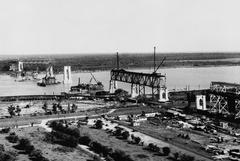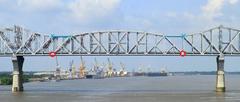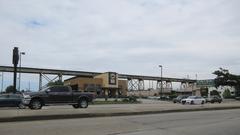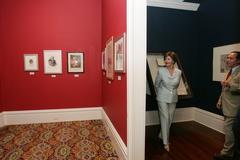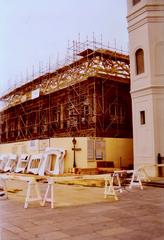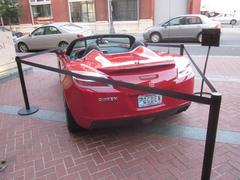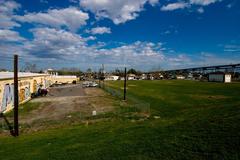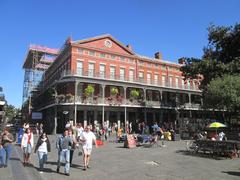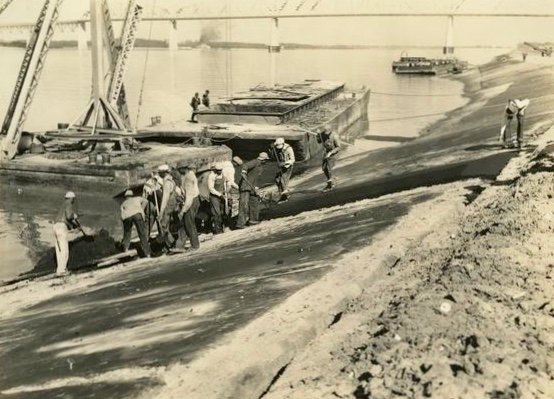
Visiting Huey P. Long Bridge in New Orleans: Hours, Tickets, and Tips
Date: 01/08/2024
Introduction
The Huey P. Long Bridge, an engineering marvel located in Jefferson Parish, Louisiana, just west of New Orleans, is not only a significant historical landmark but also a testament to early 20th-century architectural prowess. Named after Louisiana’s influential Governor Huey P. Long, the bridge was completed in 1935, shortly after Long’s assassination. Designed by the renowned engineer Ralph Modjeski, who also designed notable structures like the Benjamin Franklin Bridge in Philadelphia, the Huey P. Long Bridge was the first to span the Mississippi River in Louisiana (ASCE, Wikipedia). This cantilevered steel through-truss bridge not only revolutionized transportation in the region by replacing a cumbersome ferry system but also played a crucial role in connecting the Port of New Orleans to the broader rail infrastructure, thereby boosting the local economy (ASCE, PRCNO). Today, the bridge continues to be a vital artery for both vehicular and rail traffic, having undergone significant modernizations, including a major widening project completed in 2013 to accommodate increasing traffic demands (ILoveBridgesAndTunnels). Visitors to the bridge can appreciate its historical significance, architectural beauty, and the panoramic views it offers of the Mississippi River and the surrounding region, making it a must-visit landmark for history buffs, engineering enthusiasts, and tourists alike.
Table of Contents
- History of the Huey P. Long Bridge
- Evolution and Modernization
- Legacy and Cultural Impact
- Visitor Information
- Nearby Attractions and Accessibility
- Travel Tips
- FAQ
History of the Huey P. Long Bridge
Construction and Design
The Huey P. Long Bridge, located in Jefferson Parish, Louisiana, is a marvel of engineering and a significant historical landmark. Construction of the bridge began in 1932 and was completed in December 1935, shortly after the assassination of its namesake, Governor Huey P. Long. The bridge was designed by the renowned Polish-American engineer Ralph Modjeski, who was also responsible for other notable bridges such as the McKinley Bridge in St. Louis and the Benjamin Franklin Bridge in Philadelphia (ASCE).
The bridge is a cantilevered steel through-truss structure, a design that was common for large bridges mixing rail tracks and highways during that era. It spans the Mississippi River at mile 106.1 and features a central 4.4-mile rail track, making it the longest railroad bridge in the United States at the time of its completion (Wikipedia).
Strategic Location and Purpose
The location of the Huey P. Long Bridge, several kilometers upriver from New Orleans, was influenced by both geographical and political factors. While it is often said that Governor Long preferred rural Louisiana over urban New Orleans, the primary reason for the bridge’s location was the geography of railroads. The bridge was strategically placed to serve the railroads and rural Jefferson Parish, rather than the urban core of New Orleans (PRCNO).
Before the bridge was built, trains had to rely on a cumbersome ferry system to cross the Mississippi River. The completion of the Huey P. Long Bridge revolutionized transportation in the region by providing a more efficient and reliable means of crossing the river. This was particularly beneficial for the Port of New Orleans, which became better connected to the rail infrastructure on both banks of the river (ASCE).
Engineering Feats and Challenges
The construction of the Huey P. Long Bridge was a colossal project that required innovative engineering solutions. One of the unique aspects of the bridge’s foundation is that it rests entirely on a bed of sand. Since normal bedrock is about 1,000 feet beneath the riverbed at this location, the bridge supports are built on a fine sand mass that holds each pier in place. The stability of the piers is ensured by the massive amount of steel and concrete used in the construction, with the sheer weight of the bridge holding it in place (ILoveBridgesAndTunnels).
The bridge’s superstructure comprises about 17,000 tons of steel, and its total length, including approaches, is just under 22,996 feet (4.35 miles). The four main spans of the bridge are 2,375 feet long, with the longest barge span measuring 790 feet across the middle of the river. The bridge also features three separate river channels flowing underneath it (ILoveBridgesAndTunnels).
Historical Significance
The Huey P. Long Bridge holds a special place in the history of Louisiana and the United States. It was the first bridge to span the Mississippi River at New Orleans and remains one of the great engineering accomplishments for railway and highway bridges in the country. The bridge was designated as a National Historic Civil Engineering Landmark by the American Society of Civil Engineers (ASCE).
The bridge’s construction was part of Governor Huey P. Long’s broader legacy of public works projects in Louisiana. Long, a populist governor, was known for his ambitious infrastructure projects aimed at improving the state’s transportation network and boosting its economy. The bridge stands as a testament to his vision and commitment to public service (NewOrleansHistorical).
Evolution and Modernization
Over the years, the Huey P. Long Bridge has undergone several modifications and expansions to accommodate increasing traffic demands. Originally built with two lanes for vehicular traffic, the bridge was widened to six lanes in 2013. Today, it carries an average of 37,000 vehicles per day, along with two tracks of the Union Pacific Railroad (ILoveBridgesAndTunnels).
The bridge’s design has also influenced the construction of other similar structures. A second Huey P. Long Bridge, built in 1940 in Baton Rouge, Louisiana, closely resembles the design of the original bridge in New Orleans. While many other bridges from the same era have been converted to either entirely rail or road use, both Huey P. Long Bridges continue to carry both types of traffic (Wikipedia).
Legacy and Cultural Impact
The Huey P. Long Bridge is more than just a transportation structure; it is a cultural and historical icon in Louisiana. It symbolizes the state’s progress and development during the early 20th century and serves as a reminder of the transformative impact of infrastructure projects on local communities. The bridge’s construction marked a significant milestone in the history of New Orleans and the surrounding region, paving the way for future advancements in transportation and commerce (PRCNO).
Visitor Information
Visiting Hours and Tickets
Currently, the Huey P. Long Bridge is accessible to the public at any time as it is a functional bridge with no specific visiting hours. There are no tickets required to visit the bridge, and it can be viewed from various points in Jefferson Parish and New Orleans.
How to Get There
The bridge can be accessed via US Route 90, which crosses the Mississippi River. For those traveling from downtown New Orleans, it is a short drive westward on US 90. Ample parking is available near the bridge for visitors who wish to view it from nearby parks or scenic points.
Nearby Attractions and Accessibility
The Huey P. Long Bridge is in close proximity to several attractions in Jefferson Parish and New Orleans, including the Audubon Zoo, the New Orleans Museum of Art, and the historic French Quarter. The bridge area is accessible to visitors with disabilities, with several viewing points and parks designed to accommodate all guests.
Travel Tips
- Best Times to Visit: The best times to visit the Huey P. Long Bridge are during the early morning or late afternoon when the lighting is ideal for photography.
- Parking Information: Visitors can find parking at nearby parks and public areas that offer scenic views of the bridge.
- Nearby Accommodations: There are numerous hotels and accommodations in New Orleans and Jefferson Parish, suitable for various budgets.
FAQ
What are the visiting hours for the Huey P. Long Bridge?
The Huey P. Long Bridge is accessible 24/7 as it is a functional bridge.
Is there a fee to visit the Huey P. Long Bridge?
No, there is no fee to visit the bridge.
How can I get to the Huey P. Long Bridge?
The bridge can be accessed via US Route 90, a short drive from downtown New Orleans.
Conclusion
The Huey P. Long Bridge stands as an architectural and engineering marvel, reflecting the ingenuity and foresight of its designers and builders. Its historical significance, combined with modern enhancements, ensures that it continues to play a crucial role in the region’s transportation infrastructure. Whether you are a history buff, an engineering enthusiast, or a casual tourist, the Huey P. Long Bridge offers a fascinating glimpse into the past and present of New Orleans’ architectural and engineering achievements.
References
- American Society of Civil Engineers. (n.d.). Huey P. Long Bridge. ASCE
- Wikipedia contributors. (n.d.). Huey P. Long Bridge (Jefferson Parish). Wikipedia
- Preservation Resource Center of New Orleans. (n.d.). Bridges That Shaped Metro New Orleans. PRCNO
- ILoveBridgesAndTunnels. (n.d.). Huey P. Long Bridge, New Orleans, LA. ILoveBridgesAndTunnels
- Historic Bridges. (n.d.). Huey P. Long Bridge, New Orleans, LA. Historic Bridges
- Engineering News-Record. (2013). New $1.2 Billion Bridge Expansion Completed in New Orleans. ENR
- Heart of Louisiana. (n.d.). Huey Long Bridge. Heart of Louisiana
- Gribblenation. (2024). Huey P. Long Bridge, New Orleans, LA. Gribblenation
- Travellers Worldwide. (n.d.). Best Time to Visit New Orleans. Travellers Worldwide
